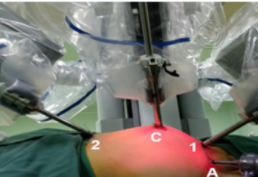Objective To explore the clinical utilization value of fluorescent lymphnodes detection with Indocyanine Green (ICG) in robotic prostatectomy and pelvic lymphnode dissection.
Methods In this study, from Jan. 2018 to Dec. 2018, 60 prostate cancer patients, 30 in fluorescence guided surgery group and 30 in control group, who underwent robotic prostatectomy in the First Hospital of Shanxi Medical University. And their clinical data were retrospectively analyzed. Among 30 patients with fluorescence guided surgery, the average age was (62±8) years, BMI was (22.8±1.4) kg/m2, PSA level was (81.2±1.2) ng/dl, prostatic volume was(57.5±1.4) ml and 14(46.73%) patients with Gleason score ≤7. In the control group, the average age was (61±7) years, BMI was (22.7±1.3) kg/m2, PSA level was (82.4±1.2) ng/dl, prostatic volume was (56.9±1.3) ml and 11(43.30%) patients with Gleason score ≤7. All parameters were comparable between the two groups. Patients in study group, before the prostatectomy, received endorectal ultrasound guided transperineal prostatic injection of ICG (5 mg). Firefly endoscopy were utilized during the fluorescent lymph nodes resection. Resected lymph tissue was marked, counted and sent to pathology. Intraoperative and postoperative data was collected, no significant differences were found in incidence of advert events and biochemical reccurence.
Results Among patients received endorectal ultrasound guided transperineal prostate ICG injection, one case had leakage. In all 30 patients, it was able to identify fluorescent prostatic capsule which were well distincted from adjacent structures. Fluorescence lymph node (FLN) packets were observed in all 30 patients and fluorescence guided resected tissue was pathologically confirmed lymph tissue. There were total 970 lymph nodes resected in both groups, 526(17.5/person) in study groups, which was significantly more than the control group 444(14.8/person). Total fluorescence rate in study group was 89.6%. Postoperative complications and incidence of reccurence was comparable.
Conclusion Transperineal injection ICG induced fluorescence guided robotic assisted prostatectomy was proved stable and reliable in this study which could be used as guidance of surgical resection strategy.
